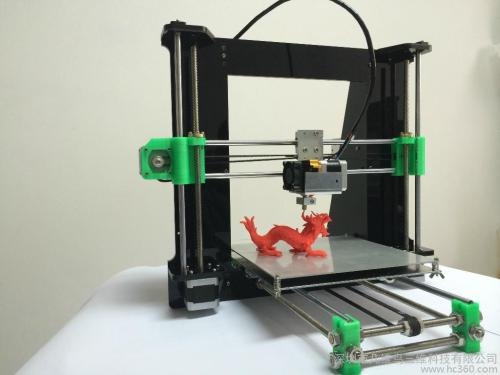Research and development of 3D printer
Production, sales and service
An innovative enterprise
High tech Enterprises

Based on 3D printing technology, designers can control the internal structure of the product to achieve the best results. For example, replacing a whole block with lattice or honeycomb like internal structure can reduce the weight of the product without sacrificing strength.
In addition, researchers are working on a range of technologies to control the performance of print pieces, and even fine control of the microstructure of metals, which will essentially change the underlying atoms and molecular arrangements of the material. For example, traditional metal forging technology (i.e. compression molding) requires metal cooling from outside to inside, while 3D printing of metal uses rapid solidification, which leads to more uniform microstructure. Therefore, the engineer can control the strength, hardness, elasticity, flexibility and pressure resistance of the finished product.
In some materials, 3D printing is not only a good choice, but also an ideal production mode. Titanium is an example - light weight, stronger strength (density) than steel, and more corrosion resistance than stainless steel. In fact, titanium is a near perfect metal choice in many applications. However, in addition to the high cost, the main disadvantage of titanium is that it is easy to harden during cutting, which leads to severe tool wear; in the welding process, it is easy to be polluted, which leads to the easy falling off of welding points. However, 3D printing technology can control titanium well because titanium has become a very fine powder at this time, only adding sintering continuously, without any processing problems, no cutting or welding.
Cost advantage
You used to find a factory to make a hammer for you. First, you must pay at least RMB 50000 to 100000 for the mold opening. If the output is less than 100, the price of a single piece can be as high as several hundred yuan. So if you do just one or more hammers, the cost will be extremely high. However, for 3D printers, the cost of equipment is the same for a product or a thousand products.
In addition, another difference between 3D printing and traditional manufacturing is the product formation process. In traditional manufacturing process, the method of reduction is usually used, including grinding, forging, bending, forming, cutting, milling, welding, bonding, assembly, etc. In the whole process, a lot of raw materials will be wasted, and a lot of energy consumption will be generated during the process of metal heating and reheating.
In contrast, 3D printing technology has shown significant value in small batch printing. First, there is no need to purchase various machines, such as lathe, milling machine, grinder, etc., which saves a large amount of equipment procurement and maintenance costs. At the same time, because of the controlled layer of material addition, processing waste is also greatly reduced, can leave 90% of the raw materials. Taking a foreign manufacturer as an example, by using 3D printing (melt deposition molding method, i.e. FDM) to customize a special part of injection molding model, the manufacturing cost decreased from $10000 to $600, the production time decreased from 4 weeks to 24 hours, and the weight was reduced by 70% - 90%.
More importantly, 3D printing technology has obvious advantages in sample design and manufacturing, which avoids the process of mold manufacturing, improves the speed of R & D and reduces the cost of R & D failure. Of course, 3D printing technology can also be used as a auxiliary tool for mass production, such as the manufacturing of dies and other tools. Traditional processing methods generally need to be the auxiliary tools for mass production, such as the manufacturing of moulds and other tools. It usually takes a month to use traditional processing methods, and 3D printing can be completed within 48 hours.
In the aspect of direct product manufacturing, for example, the integrated manufacturing of multi-layer circuit once forming by 3D printing can have obvious speed advantage.
More importantly, 3D printing has the advantage of "printing as you need". When the customer orders, locate a cloud manufacturing node closest to the physical location of the customer to start manufacturing, and then deliver it to the door quickly, which saves the cost of product inventory and logistics.
The application status of 3D printing
The advantages of 3D printing are introduced in the previous section. It is these advantages that ignite the fuse of the third industrial revolution in the world. However, 3D printing applications have just begun to be widely used, and there must be many imperfections, such as relatively low manufacturing accuracy, slow manufacturing speed of simple structural parts, etc.
3D printing needs to rely on cutting-edge technologies in many disciplines, including at least three technologies, namely information technology, precision machinery and material science. By combining with the manufacturing methods of numerical control processing, casting, metal cold spraying and silica gel mold, it has been applied in aerospace, automobile motorcycle, home appliances, biomedical and other fields, and also occupies a unique position in engineering and teaching research and other fields. The specific application areas include at least the following.
Biomedical: used to make artificial bones, teeth, hearing aids, prosthetics, etc. Aerospace, national defense and military industry: used to directly manufacture complex shape, micro size, special performance parts. Consumer goods: design and manufacture of jewelry, clothing, footwear, toys and creative DIY works. Cultural creativity and digital entertainment: artistic expression through the design of works with complex shapes and structures and special materials. The 3D printed violin is close to the level of craftsmanship. Industrial manufacturing: used for product conceptual design, prototype production, product review, function verification; mold prototype, direct printing mold, and even direct printing of products. 3D printing of small unmanned aircraft, small vehicles and other concept products have been published. 3D printing household appliance model is also used in the promotion and marketing activities of enterprises. Construction Engineering: wind dynamic experiment and effect display of building model, construction simulation of construction project. Education: print models to verify scientific assumptions for experiments and teaching in different disciplines. In some North American secondary schools, general colleges and military colleges, 3D printing has been used for teaching and research.
Prototype manufacturing of new products is the most important commercial application of 3D printing, accounting for 70% of the 3D printing market. Prototype enables designers (and their customers) to touch and test design concepts or functional implementations early in the design phase, thus avoiding the expensive costs of subsequent changes and saving a lot of time and money for the launch of new products. Take Akaishi, a Japanese manufacturer of health shoes and massage equipment, for example. The company found that through 3D printing prototypes, new products have been reduced by 90 percent from ordering to delivery, and that designers have 100 percent confidence in functionality before they are available. Prototypes also facilitate experimentation and innovation, such as the use of 3D printing technology, which allows Bell Helicopter to complete new design tests in days, while it takes weeks to use traditional methods.
In some industries, 3D printing has developed from prototype manufacturing to direct part production, also known as direct digital manufacturing. Eoir technology is a leading defense system design and development company, which uses 3D printers to make solid and durable tank external equipment. Since the introduction of 3D printing technology, the company's manufacturing costs have been from the original manufacture of robust tank external equipment. Since the introduction of 3D printing technology, the company's manufacturing costs have fallen from over $100000 per unit to less than $40000 today. For example, in the field of aerospace, Airbus makes metal wing supports by 3D printing. Because 3D printing can easily make any complex hollow shape inside, the weight of components is lighter, and the weight of aircraft is reduced, thus saving fuel.
Shenzhen Huafast Industry Co.,Ltd
website: 68818888.cn
Contact person: Sven
Mobile: 18565876617 / 18820161941
WhatsApp:+86-18820161941
Email: 873304168@qq.com
Address: 2nd floor, building 2, No. 339, Huaqing Road, Qinghu, Longhua street, Longhua District, Shenzhen

Wechat code scanning offers!
Shenzhen Huafast Industry Co.,Ltd all rights reserved
Address: 2nd floor, building 2, No. 339, Huaqing Road, Qinghu, Longhua street, Longhua District, Shenzhen